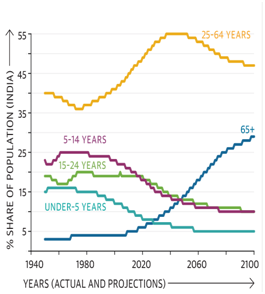

Context
Ministry of Statistics and Programme Implementation has released ‘Youth in India 2022’ report.
Background
- After the new economic policy in 1991, India had experienced a demographic transition with increasing share of young age population.
- The story of demographic dividend, where the young age population serves as the spine of the economy, continues till 2016.
- Report from UN World Population Prospects has cited that India will outnumber China in the next year, attaining the first place in the size of population.
- The window of demographic dividend is on closing phase as, India is experiencing a downward trend in the share of young age population and rise in old age population.
Analysis
Key Highlights of the ‘Youth in India 2022’ report:
- The number of young people is expected to increase initially but start to decline in the second half of the 2011-2036 period.
- Youth in the 15-29 age group will make up 27.2 percent of the population in 2021, which is expected to decrease to 22.7 percent by 2036.
- The more populous states of Bihar and Uttar Pradesh, which saw an increase in the proportion of the youth population to the total population by 2021, are expected to decline.
- States like Kerala, Tamil Nadu and Himachal Pradesh are expected to see a higher number of elderly people than young people by 2036.
Definition of Youth:
- No universal definition: There is no universal definition of youth, various departments and organisations provide their own definitions.
- Definitions from various institutions:
|
Organisations/ Institutions |
Age Group |
|
UN Secretariat/UNESCO/ILO/WHO/UNFPA |
15-24 |
|
UN Habitat (Youth Fund) |
15-32 |
|
UNICEF |
Under 18 |
|
African Youth Charter |
15-35 |
|
National Youth Policy, 2014 |
15-29 |

What are the major concerns highlighted in the Youth India Report 2022?
- Declining young population:The proportion of youth to population has increased from 26.6% in 1991 to 27.9% in 2016, and projected to begin a declining trend reaching to 22.7% till 2036.
- Increasing old aged population: The old aged population has increased from 6.8% in 1991 to 9.2% in 2016, and expected to increase touch 14.9% in 2036
- Demographic transition: India’s window for demographic dividend is closing as the share of the youth population is on a declining trend and the share of the old aged population is increasing.
- Demographic disaster: Demographic dividend with appropriate education and skill development, increasing the risk of demographic disaster.
- Increasing dependency ratio: Rising old aged population will increase nation’s dependency ratio.
- Decline in national savings: Increased dependency ratio will create a negative impact on the position of national savings.
- Impact on investment: Declined national savings reduces the investment capacity of the nation.
- Demand for health care:A greater proportion of youth at present will result in a greater proportion of elderly in the population in future, creating a demand for better healthcare facilities.
- Social security: Increased old aged population will put pressure on social security and the public welfare system.

What are the major issues with India’s population?
- Education and population growth: Poverty and illiteracy have been subjected to high population growth.
- Unemployment: High youth unemployment serves as the catalyst in the process of transforming demographic dividend into demographic disaster.
- Resource scarcity: India with 2% of world’s total landmass accommodates around 17% of world’s total population, putting an additional pressure on resource allocation and availability.
- Fast growth: A mismatch in the death rate and birth rate contributing to faster growth rate.

What measures can be taken?
- Productive job creation: Creation of more productive jobs can help to utilize the demographic dividend.
- Expansion of manufacturing sector: Manufacturing sector needs to foster to create more opportunities for jobs and employment.
- Universal Health care facilities: More numbers of old population need robust health care facilities.
- Sustainable Social security measures: Increasing number of old aged population will demand for better social security.
- Implementation of labour codes and active labour market policies needs to be adopted.
- Revision in National Youth Policy on a regular interval.
|
India’s Schemes and Policies for Older Persons:
|



